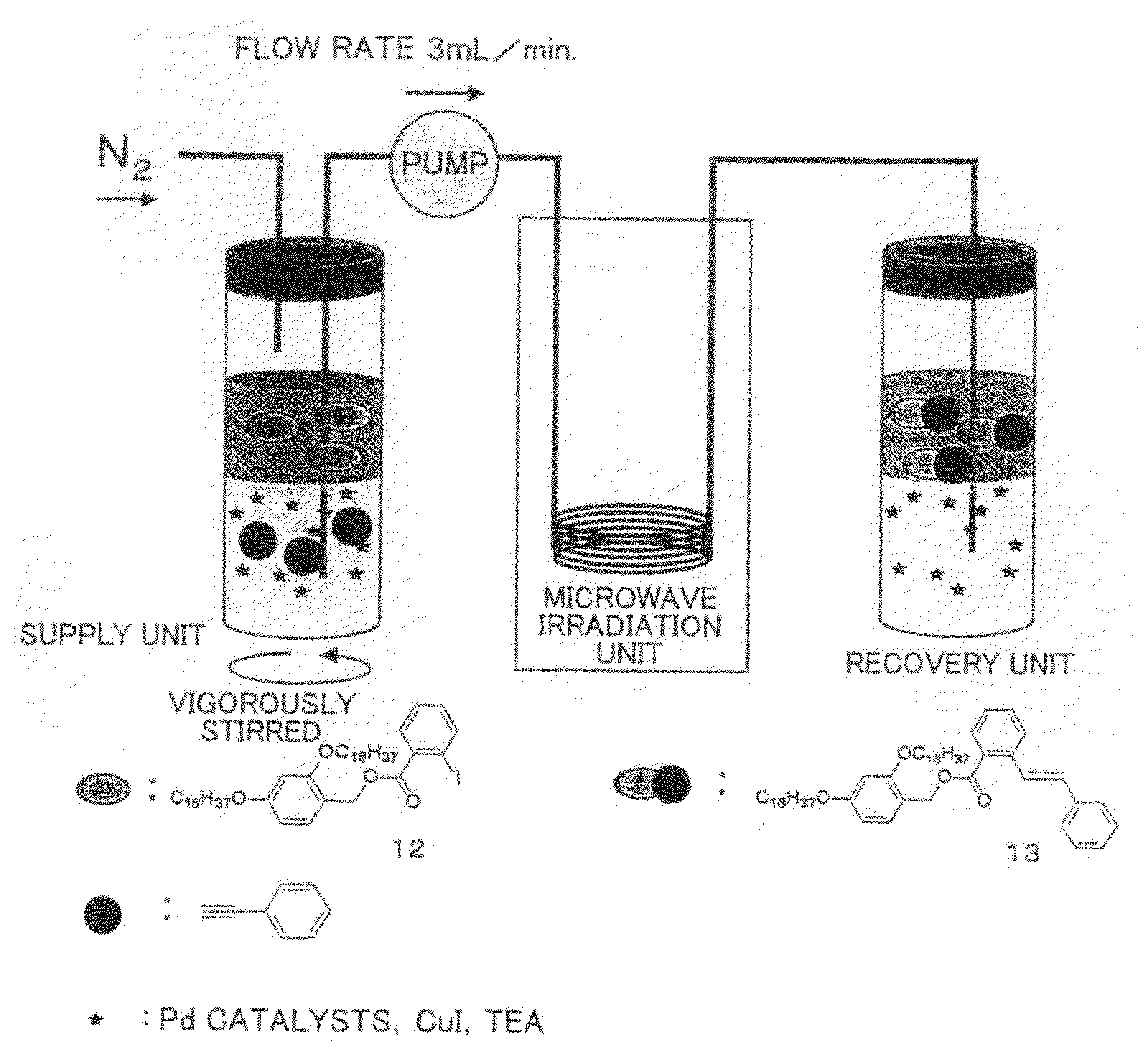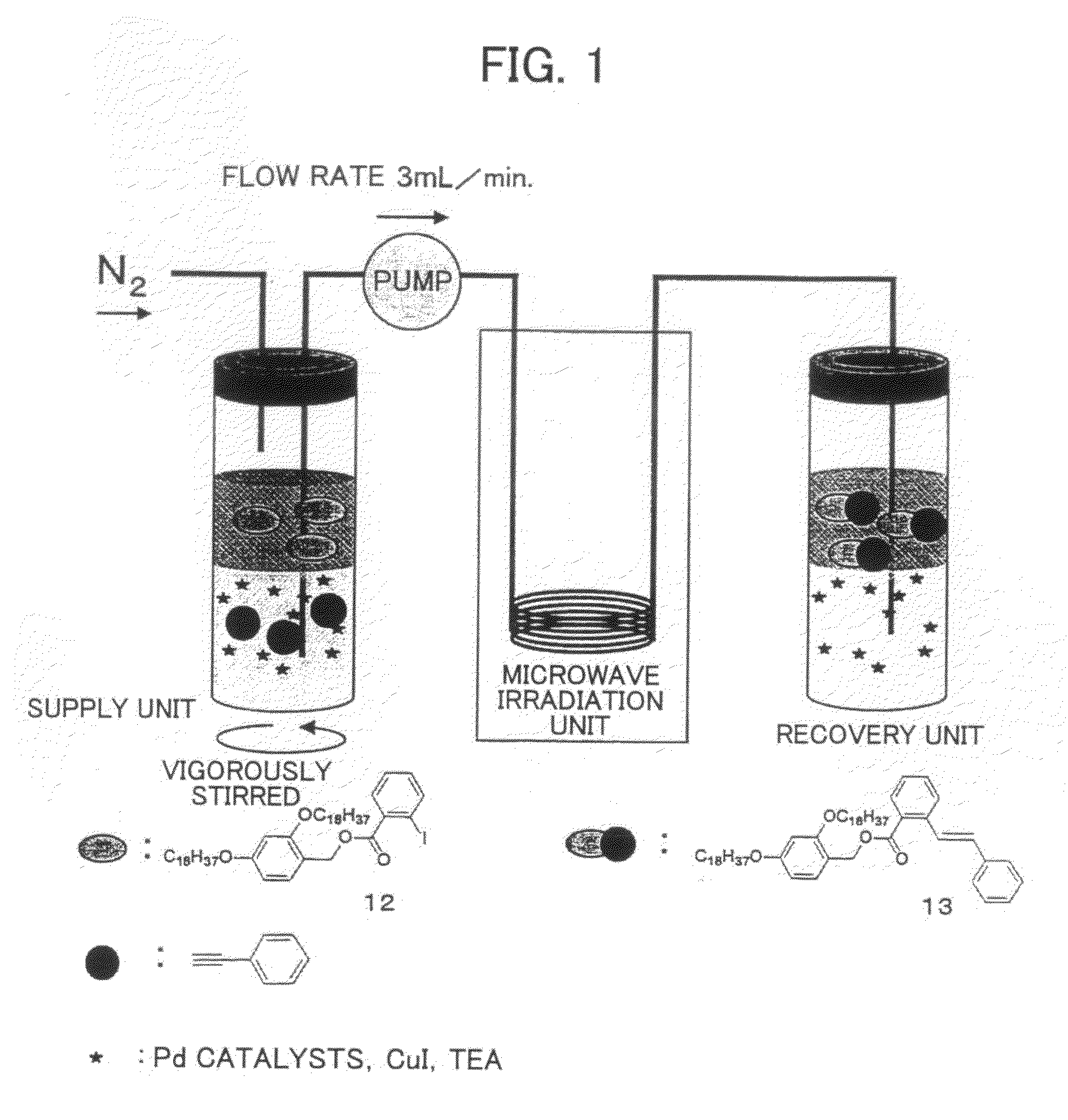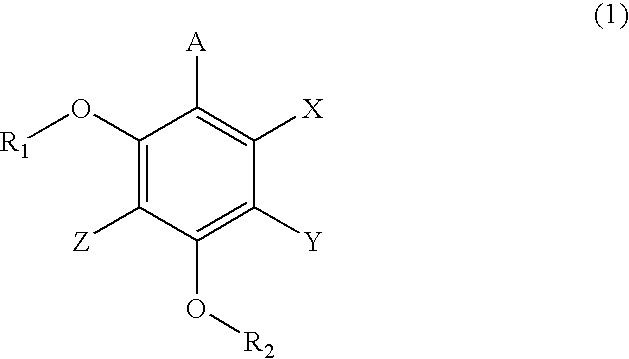Carrier for Separation, Method for Separation of Compound, and Method for Synthesis of Peptide Using the Carrier
a carrier and compound technology, applied in the field of carrier and compound separation, can solve the problems of requiring enormous amounts of money and time for process development, and achieve the effects of convenient evaluation, high purity, and efficient separation
- Summary
- Abstract
- Description
- Claims
- Application Information
AI Technical Summary
Benefits of technology
Problems solved by technology
Method used
Image
Examples
example 1
Synthesis of Carrier for Separation
[0163]Hereinafter, a synthesis process chart of the carrier for separation of the present invention (compounds 2 and 5 in the FIGURE) is shown. Numerals in the figures represent the compound numbers.
Synthesis of 2,4-bisoctadecyloxyphenylmethanol (Compound 2)
[0164]After 2,4-dihydroxybenzaldehyde (compound 1) (1 g (0.0072 mol)) and octadecyl bromide (4.82 g (0.0145 mol)) were dissolved in dimethylformamide (DMF) (20 ml), potassium carbonate (5 g (0.0372 mol)) was added, and the resulting mixture was stirred under a nitrogen atmosphere at 100° C. for 6 hours. The reaction liquid thus obtained was extracted with hexane (3×100 ml), and subsequently this hexane solution was concentrated under vacuum. Methanol (MeOH) (200 ml) was added to the residue, and crystals thus produced were separated by filtration. After crystals thus obtained were dissolved in tetrahydrofuran (THF) (80 ml) and methanol (MeOH) (30 ml), sodium borohydride (0.7 g (0.0184 mol)) was ...
example 2
Synthesis of 2,4-bis-(2-decyl-tetradecyloxy)-phenylmethanol (Compound 5)
[0172]2-Decyl-1-tetradecanol (compound 3) (9.7 g (0.0274 mol)) and pyridine (10.6 g (0.134 mol)) were dissolved in dichloromethane (100 ml), and tosyl chloride (15.5 g (0.0813 mol)) was added under stirring in an ice bath. After stirring for 3 hours at room temperature, ice water (20 ml) was added to the mixture to terminate the reaction. Hexane (200 ml) was added to the obtained reaction solution, and after washing the organic layer with 1 N HCl (3×100 ml), it was washed with a saturated sodium bicarbonate aqueous solution (3×100 ml), and further with a saturated NaCl solution three times. After drying over anhydrous magnesium sulfate, the solvent was distilled off under vacuum to obtain compound 4 (toluene-4-sulfonic acid 2-decyl-1-tetradecyl ester). The yield was 88%.
[0173]1H-NMR (300 MHz, CDCl3)
[0174]δ 7.78 (d, J=8.25, 2H), 7.33 (d, J=8.44, 2H), 3.91 (d, J=5.14, 2H), 2.44 (s, 3H), 1.65-1.51 (m, 1H), 1.38-1.0...
example 3
Separation Method Using Carrier for Separation
[0178]Hereinafter, a process chart of the separation method using the carrier for separation (compound 2) obtained in Example 1 is shown. Numerals in the figures represent the compound numbers.
First Binding Process
[0179]Compound 2 (2,4-bis-octadecyloxyphenylmethanol), the carrier for separation of the present invention obtained in Example 1 (1 g (1.5502 mmol)), 4-iodobenzoic acid (0.77 g (3.1046 mmol)) and dimethylaminopyridine (100 mg (0.8195 mmol)) were dissolved in dichloromethane (50 ml), and diisopropylcarbodiimide (0.98 g (7.7778 mmol)) was further added, and the resulting mixture was stirred for 2 hours at room temperature. Subsequently, after distilling off the solvent under vacuum, methanol (MeOH) (200 ml) was added to the residue, and crystals were filtered to obtain 4-iodo-benzoic acid 2,4-bis-octadecyloxybenzyl ester (compound 7). The yield was 81%.
[0180]1H-NMR (300 MHz, CDCl3)
[0181]δ 7.78-7.71 (m, 4H), 7.27 (d, J=8.4, 1H), 6...
PUM
| Property | Measurement | Unit |
|---|---|---|
| carbon number | aaaaa | aaaaa |
| carbon number | aaaaa | aaaaa |
| temperature | aaaaa | aaaaa |
Abstract
Description
Claims
Application Information
 Login to View More
Login to View More - R&D
- Intellectual Property
- Life Sciences
- Materials
- Tech Scout
- Unparalleled Data Quality
- Higher Quality Content
- 60% Fewer Hallucinations
Browse by: Latest US Patents, China's latest patents, Technical Efficacy Thesaurus, Application Domain, Technology Topic, Popular Technical Reports.
© 2025 PatSnap. All rights reserved.Legal|Privacy policy|Modern Slavery Act Transparency Statement|Sitemap|About US| Contact US: help@patsnap.com



